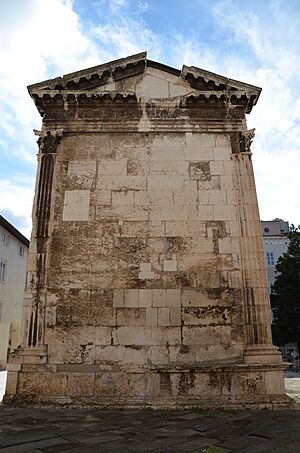Opus isodomum facts for kids

Opus isodomum is an ancient way of building walls. It uses stone blocks that are cut perfectly. These blocks are all the same height, and sometimes even the same length.
Opus pseudoisodomum is a similar building method. In this style, the stone blocks are still cut perfectly. However, their heights and lengths are not always the same.
Both of these building styles were very strong and popular in ancient times.
Contents
Building with Perfect Blocks: Opus Isodomum
Opus isodomum means "equal courses" in Latin. This building technique uses stone blocks that are all the same size. Imagine building a wall with LEGO bricks that are all exactly alike!
How Opus Isodomum Works
- All stone blocks are cut to be the same height.
- Often, they are also cut to be the same length.
- The blocks are placed in perfectly even rows, one on top of the other.
This method made walls look very neat and strong.
Where Was Opus Isodomum Used?
This building style was very popular in classical antiquity, which means ancient Greek and Roman times. Builders used it a lot for important public buildings like:
- Temples (such as the famous Parthenon in Greece)
- Theaters
- Amphitheaters (like the Colosseum)
It was a sign of skilled craftsmanship and strong construction.
Building with Varied Blocks: Opus Pseudoisodomum
Opus pseudoisodomum means "false equal courses." This method is a bit different from opus isodomum.
How Opus Pseudoisodomum Works
- The stone blocks are still cut very precisely.
- However, the rows of blocks are not all the same height.
- The lengths of the blocks can also vary.
Even though the blocks are not all the same size, this method still creates a very strong wall.
How Ancient Builders Joined the Stones
Ancient builders had clever ways to make these stone walls extra strong.
Using Mortar
Sometimes, they used mortar to bind the stone blocks together. Mortar is a mix of sand, cement, and water that acts like glue.
Using Metal Ties
More often, especially for very important buildings, they did not use mortar. Instead, they used strong metal ties.
- These ties were often made of iron.
- They were shaped like cramps (like big staples).
- Builders would fix these metal ties into the stone blocks.
- Then, they would pour hot, melted lead around the ties. When the lead cooled, it would hold the ties firmly in place, connecting the blocks together.
This method made the walls incredibly stable and able to last for thousands of years.
Strengthening the Walls
Even with perfectly cut blocks, builders had tricks to make walls even stronger.
When using blocks of the same height but different lengths, they made sure that the ends of the blocks in one row did not line up exactly with the ends of the blocks in the row above or below it. This is like how you would build a brick wall, where the vertical lines between bricks are staggered. This helps spread the weight and makes the wall much more stable.
What Vitruvius Said
Vitruvius was a famous Roman architect and writer. He lived in the 1st century BC. He wrote a very important book called De Architectura (About Architecture).
In his book, Vitruvius described both opus isodomum and opus pseudoisodomum. He said that a wall is called "isodomum" when all its rows of stone are of equal height. He also mentioned that "pseudoisodomum" walls have rows that are not equal in height.
Vitruvius believed that both of these building methods were originally from Greece. He also emphasized that "both kinds are strong," showing how effective these ancient techniques were.
Images for kids
See also
 In Spanish: Aparejo isódomo para niños
In Spanish: Aparejo isódomo para niños


